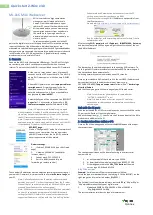
Example: If the value is .456789, then IFS3 truncates to shows milliseconds (".456"), but IFS.3
would round it to ".457".
6.
NUMn always inserts the number of digits ('n') specified. The number is chosen by finding the highest
numbered field of a similarly-named clip, and adding 1. For example, the pattern "XYZ#NUM4" would
produce the following names:
XYZ0000
XYZ0001
XYZ0002
7.
OPTn works similar to NUMn, except that the number is only inserted if necessary to make a unique
name. The other difference is that OPTn prepends and underscore before the number, but only if the
number is required. For example, "XYZ#OPT4" would produce the following names:
XYZ
XYZ_0000
XYZ_0001
8.
Other Punctuation
Miscellaneous punctuation can be inserted between rule fields without necessarily having to switch to
literal mode and back each time. For example, to render clip duration as a normal timecode string
("HH:MM:SS:FF"), use this rule:
#Chr2#:#Cmi2#:#Cse2#:#Cfr2
You can insert the colons more simply:
#Chr2:Cmi2:Cse2:Cfr2
If, however, you want to insert text or numbers, you must treat them as literals:
H=
#Chr2#,M=#Cmi2#,S=#Cse2#,F=#Cfr2
9.
The default
clip naming
string is
#Dmo2Ddm2Dyr2_Thr2Tmi2Tse2,
which names clips with the date_time
format QuVIS has also used.
QuVIS Acuity
™
Page 157
QSR Version 3.3
Содержание Acuity
Страница 1: ......
Страница 152: ...Keyboard Hotkeys Description ENTER Complete current edit QuVIS Acuity Page 151 QSR Version 3 3...
Страница 190: ...QuVIS Acuity Page 189 QSR Version 3 1...
Страница 200: ......
















































